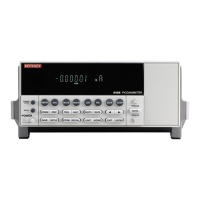Model 6485 Picoammeter Instruction Manual Measurements 3-3
Perform the following steps to measure current:
Step 1. Enable zero check
Zero check should always be enabled before making connection changes. The ZCHK key
toggles zero check on and off. When on, the “ZC” or “ZZ” message is displayed. See
Section 2 for details on zero check.
Step 2. Perform zero correction
To achieve optimum accuracy for low current measurements, it is recommended that you
zero correct the picoammeter. (See Section 2 for details on zero correction:)
-Select the 2nA range (which is the lowest range).
-Press the ZCOR key until the “ZZ” message is displayed.
Step 3. Select a manual measurement range or enable auto range
Use the RANGE and keys to select a manual measurement range, or press AUTO to
enable auto range. With auto range enabled, the instrument will automatically go to the
most sensitive range to make the measurement. See Section 4 for details on range.
Step 4. Connect the current to be measured to the picoammeter
Basic connections for measurements are shown in Figure 3-1.
WARNING A safety shield is advisable whenever floating measurements are being
made (see “Floating measurements,” page 2-12). Connections for the
safety shield are shown in Figure 3-1. The metal safety shield must
completely surround the noise shield or floating test circuit, and it
must be connected to safety earth ground using #18 AWG or larger
wire.
NOTE When not making floating measurements, it is recommended that you ground
measurement LO at only one place in the circuit, such as with the ground link
connection on the rear panel of the 6485. (See “Ground loops,” page C-2.)
Fundamental information on making connections to the picoammeter input is
provided in Section 2.
Step 5. Disable zero check and take a reading from the display
If the readings are noisy, you may want to use filtering to reduce noise. Use filtering if the
noise is caused by a noisy input signal. Filtering is covered in Section 4.

